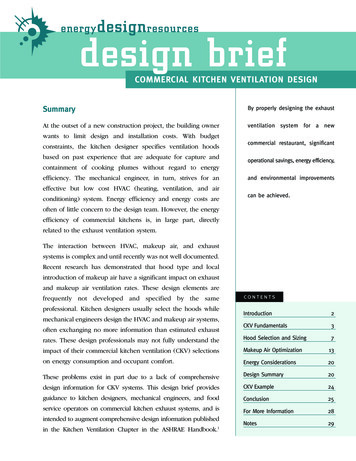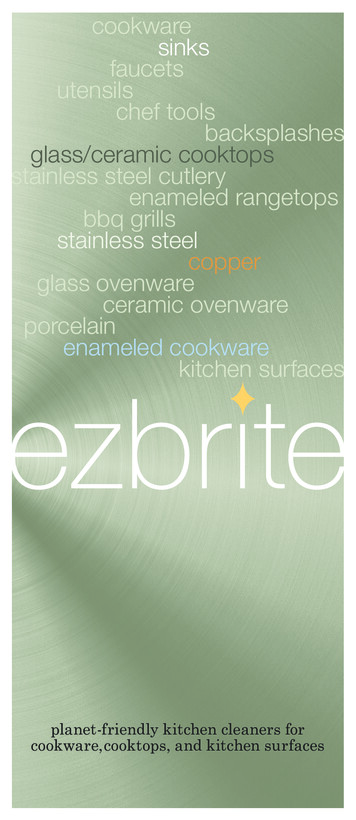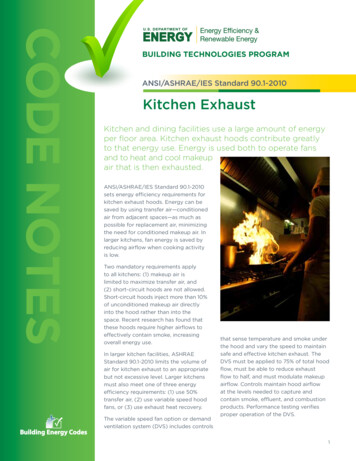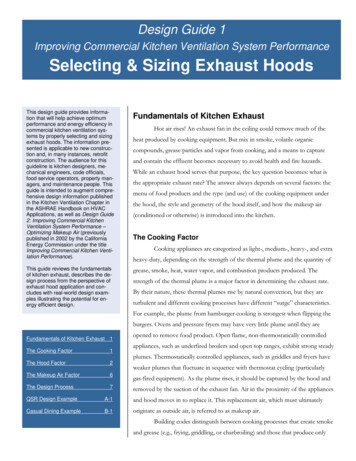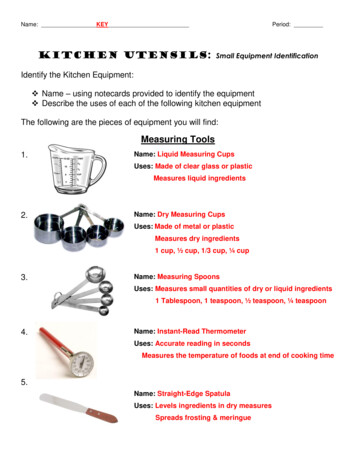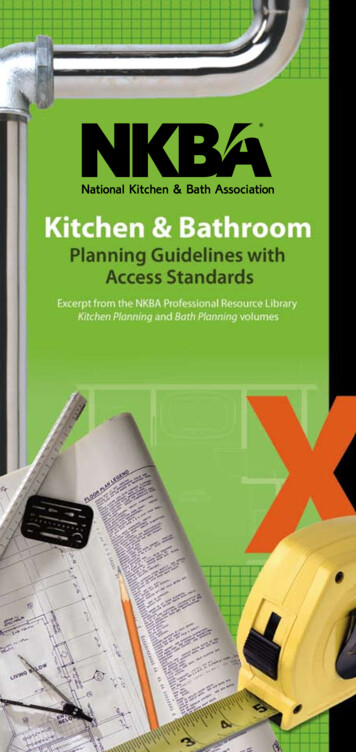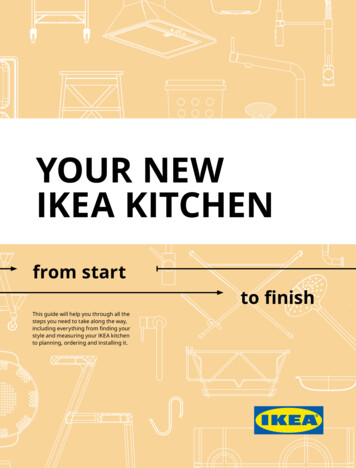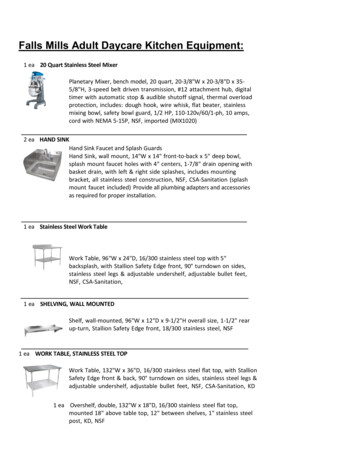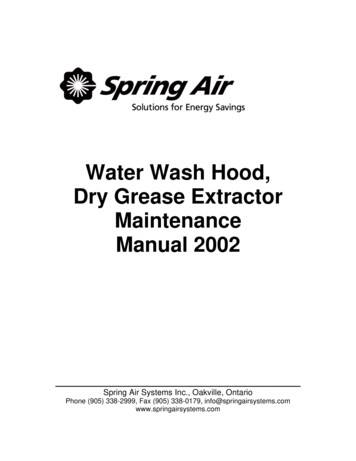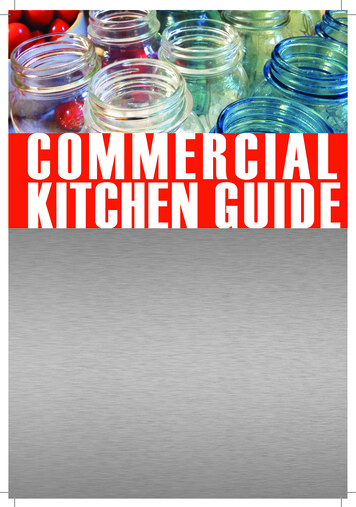
Transcription
COMMERCIALKITCHEN GUIDE1
AcknowledgementsAuthors:Karen Korslund, University of Minnesota – HumphreySchool of Public AffairsGreg Schweser, University of Minnesota - RegionalSustainable Development PartnershipsRachel Grewell, University of Minnesota - Center forUrban and Regional Affairs, Summer 2013Contributors:Editor:Jane Jewett, Minnesota Institute for SustainableAgriculture (MISA)Project Team:Kathryn Draeger, University of Minnesota - RegionalSustainable Development PartnershipsDavid Fluegel, University of Minnesota - RegionalSustainable Development PartnershipsRachel Grewell, University of Minnesota – Center forUrban and Regional AffairsKaren Korslund, University of Minnesota – HumphreySchool of Public AffairsHelene Murray, Minnesota Institute for SustainableAgricultureBrent Olson, The Inadvertent Cafe, a subsidiary of BigStone Products, LLCGreg Schweser, University of Minnesota - RegionalSustainable Development PartnershipsReviewers:Paul Hannenmann, freshArc: architecture about foodJane Jewett, Minnesota Institute for SustainableAgricultureSarah Leach, Minnesota Department of HealthHelene Murray, Minnesota Institute for SustainableAgricultureMegan O’Hara, Minnesota Institute for SustainableAgricultureJames Topie, Minnesota Department of HealthTim Jenkins, Minnesota Department of HealthSarah Leach, Minnesota Department of HealthJohn Hatzung, freshArc: architecture about foodLinda Kingery, University of Minnesota – NorthwestRegional Sustainable Development PartnershipsMichelle Leitinger, Aitkin County EnvironmentalServices.Erin Meier, University of Minnesota – Southeast RegionalSustainable Development PartnershipsBen Miller, Minnesota Department of AgricultureHelene Murray, Minnesota Institute for SustainableAgricultureMegan O’Hara, Minnesota Institute for SustainableAgricultureBrent Olson, Inadvertent CaféColleen Paulus, Minnesota Department of HealthLinda Prail, Minnesota Department of HealthPol Sorquist, Kindred KitchenNoreen Thomas, organic farmerOkechukwu Ukaga, University of Minnesota - NortheastRegional Sustainable Development PartnershipsLisa Weiskopf, Harmony Food Coop.Molly Zinns, University of Minnesota – Central RegionalSustainable Development PartnershipsDesign:Brett Olson, Renewing the CountrysideFunding provided by:University of MinnesotaSouthwest Regional SustainableDevelopment PartnershipCenter for Urban andRegional AffairsMinnesota Institute forSustainable AgricultureCopy Right:Minnesota Institute for Sustainable AgricultureAdvisers:Stephanie Anderson, Minnesota Department ofAgricultureKathryn Draeger, University of Minnesota - RegionalSustainable Development PartnershipsDavid Fluegel, University of Minnesota – SouthwestRegional Sustainable Development PartnershipsValerie Gamble, Minnesota Department of AgriculturePaul Hannenmann, freshArc: architecture about foodTim Jenkins, Minnesota Department of Health2M inneso ta Institutefo r S ustainable Ag riculture411 B o rlaug H all1991 B ufo rd CircleSt. Paul M N 55108-1013612. 625. 8235misamail@umn. ed uwww. misa. umn. ed u
Table of ContentsFor Kitchen ManagersHow to Start a Commercial KitchenWholesale or RetailImportant Considerations for Operating Your Kitchen4467For Individual Processors and Kitchen Tenants8How to start your business in a community commercial kitchenDetermining what you want to sellCreating a HACCP PlanBeginning a Relationship with your InspectorLicensing and InsurancePlan ReviewLabeling88911121213Owner and Tenant Kitchen ChecklistRegulatory GridGlossaryAppendixAppendix A: Example Community KitchenAppendix B: Kitchen EquipmentAppendix C: Regulation MatrixAppendix D: Example Questions for InspectorsAppendix E: Determining your Planning and Zoning Department Contact1416172021232930Community Commercial KitchensCommunity commercial kitchens available for rent to members of the public are arelatively new phenomenon. These kitchens are often used as incubation facilitiesfor beginning food entrepreneurs like caterers, product manufacturers, or food truckoperators. It may also be a means for local farmers to add value to raw product in orderto expand their marketing potential.reCommunity commercial kitchens are different from other community kitchens in thatthey are licensed and regulated and may be used to create products for sale in wholesaleor retail markets. Some community kitchens may be available in churches, parkfacilities, or through other local venues for various purposes but unless these kitchensare licensed as commercial kitchens, they are not permitted to be used to produceproducts for sale to the public.This guide is intended to provide information on policies and regulations for thoselooking to open or operate in a community commercial kitchen. Glossary terms will bein bold. Tenants and owners have separate sections in this guide, but it is advantageousfor both owners and tenants to be familiar with the rules that apply to each.3
For Kitchen ManagersHow to start a community commercial kitchen:This overview will focus only on the regulatory steps needed to open a communitycommercial kitchen. The order of these steps is important BUT may vary from placeto place. Conducting a feasibility study and surveying prospective tenants in order todetermine the amount and type of demand for the kitchen is a good first step.1 Afterthat, discuss your plans with a health inspector, the building department, and the zoningdepartment early-on. When meeting with these officials, be sure to write down the date,time, location of your meeting, and the person with whom you are meeting. This way youwill know who to contact if a problem or question should arise. It can also be helpful torepeat instructions you receive back to the person with whom you’re meeting to be surethat your understanding of their instructions is the same as their understanding.Contact a health inspector to discuss your plansIt will be helpful to contact your food inspector right away to establish a relationship. 2An early relationship can save you the hassle andcost of having to fix unforeseen problems later onin the process. Be sure to contact your inspector· discuss preliminary plansbefore spending money or a significant amount· identify potential issuesof time on your project. Consult your inspectorabout insurance needs and then contact your insurance company.Health Inspector:Planning and ZoningIf a commercial community kitchen will bethe primary use of your business (i.e. it will notbe secondary to another business like a café orgrocery store) it may be considered industrial use.Although it may be tempting to rehabilitate a· is a kitchen allowed in that partkitchen facility of a previous business, you mayof townrun into trouble if the previous business was not· do you need special permitszoned for industrial use (Non-industrial businesses· what inspections will you needmay include: restaurants, delis, churches, etc.).Check with your local planning and zoning authorities to see if your commercialkitchen plan is allowed in the location being considered. (See Appendix E fordetermining your planning and zoning contact)Planning & ZoningDepartment:1. Resources on conducting feasibility studies: ction/#marketing22. Map on locating your inspector: MDH /contactmap.htmlMDA http://gis.mda.state.mn.us/territories/4
Be sure to consult with the department aboutbuilding codes. Failing to do so might force you totear down and reconstruct your project accordingto applicable state codes and guidelines. The MNDepartment of Labor and Industry has directories· needed permits and inspectionsof licensed contractors. 3 Hiring an architect tofor plumbing, HVAC andhelp with this process may be helpful but notelectrical worka requirement. New building construction orsignificant alterations to an existing building willrequire inspections and permit(s). Electrical, plumbing, and HVAC (like installingventilation ducts or exhaust hoods) each typically require inspections to ensure thatadditions are installed safely or by qualified professionals. Construction in smallmunicipalities that do not issue their own building permits will require a plumbinginspection by the state plumbing inspector. 4BuildingDepartment:Create a kitchen planKitchen Plan:· understand your equipment andHaving an idea of what products will be createdinfrastructure needsin your kitchen and how many tenants will use· identify who your tenants will bethe kitchen will dictate the equipment and layout(wholesale and/or retail)that you need. Consider how you can build your· design the workspacekitchen for a wide variety of future tenants. If youmight have retail tenants in the future, you will need to provide specific, high-standardequipment for retail tenants (i.e.: NSF equipment) since this is required for them. Thisequipment is not required for wholesale operators, but they can use the same highstandard equipment retail operators are required to use. Separate storage spaces fortenant products should be maintained.A kitchen plan must be submitted and approved by the regulating agency beforeconstruction begins. (Work with your food inspector to determine the state or localregulating agency you need to contact.) To ensure the approval process will happen asquickly as possible, include all information your regulating agency has asked for. Anexample kitchen map and list of potential equipment items are given in Appendix Aand Appendix B.Your kitchen should be designed to have a logical flow, especially in regards to howfood or other processing items move from clean to dirty areas. Be prepared to discusswith inspectors how the kitchen is set up to minimize cross-contamination. In theexample kitchen layout in Appendix A, the dirtiest equipment is located in one cornerof the kitchen (three-compartment sink, garbage, mop sink, and hand washing sink)while the cleanest equipment areas are located in the opposite corner of the kitchen(Slicer, scale, storage, grill, oven, etc.). Your hand washing sink should be placed ina convenient place to minimize cross-contamination – often this is a place near the3. MN Department of Labor and Industry directories for contractors: http://www.dli.mn.gov/ccld/licverify.asp4. State Plumbing Inspector information: https://www.dli.mn.gov/CCLD/plumbinginspect.asp5
door. It’s important to be able to discuss with your inspector the ways in which yourkitchen design discourages cross-contamination.Your kitchen will need to use potable water. When constructing a commercial kitchenon your farm, or in any area that utilizes well water, you will need to coordinate withyour MDA or MDH inspector. They will design a testing schedule with you to ensureyour water does not contain unsafe levels of coliforms, e-coli, nitrates, arsenic, or othercontaminates. If unacceptable levels of contamination are present, corrective actionwill be required before you are allowed to operate out of your kitchen.Wholesale or Retail?Retail food preparers5 (licensed by MDH or a local MDH delegated agency) facedifferent regulatory standards than wholesale food manufacturers (licensed by MDA). Ifyour facilities are up to retail food preparer standards, then wholesale tenants will alsobe able to use those facilities. It may be cheaper or easier to build wholesale facilities,but then the variety of potential tenants may be limited. Potential retail tenantsinclude caterers, farmers’ market vendors, food truck operators,6 or others who prepareready-to-eat products directly for sale to the public.Another potential interest for retail tenants is the sale of value-added products atfarmers’ markets. Value-added products have been processed - like jams or salsas.Unprocessed products, like raw vegetables and berries, are exempt from licensing orkitchen requirements. Two exemptions called the “Pickle Bill”7 and the “Not PotentiallyHazardous Foods”8 allow for limited sales of certain home baked and home canned foodswithout licensing or certification. Since commercial kitchens are designed for wholesale orretail preparers who wish to sell beyond the limitations of these exemptions, tenants mustmeet licensing and certification requirements to operate in those kitchens.Wholesale operations involve sales to other entities that are one or more steps awayfrom the direct consumer. Wholesale sales may be to grocery stores, farm-to-school,farm-to-institution, and sales to aggregators or distribution companies.Meat in Wholesale ProductsMeat processing for wholesale markets is not recommended in communitycommercial kitchens since additional regulations come into play. If you use morethan 3% raw or 2% cooked meat in wholesale products, then your facilities mustbe under continuous inspection by a USDA Food Safety and Inspection Service(FSIS) inspector or a Minnesota “Equal To” inspector. 9, 105.6.7.8.6This is a term designed for this document and is not a term defined by MN statute and/or rule.Minnesota Food Truck Association: http://www.mnfoodtruckassociation.org/Pickle Bill: ode-fact-sheets/pickle-bill.aspxNot Potentially Hazardous Foods: https://www.mda.state.mn.us/food/business/ shx9. Selling Poultry: http://www.mda.state.mn.us/food/safety/ /media/Files/food/foodsafety/poultrysales.ashx10. Approved Sources of Meat/Poultry: http://www.mda.state.mn.us/food/safety/ /media/Files/food/foodsafety/meatpoultry.ashx
Wholesale production of sandwiches or pizzas containing meat products may beexempt under specific conditions from this requirement for continuous inspection,but refer to footnote nine and ten for an MDA document describing approvedsources of meat and poultry.Meat used by Food Preparers“Food preparers”5 in the community commercial kitchen context are people who makeready-to-eat food in the kitchen and then deliver it to a location where it is eaten.Their sales are considered retail since the food is being sold directly to the consumer.Since they are not selling wholesale, food preparers5 do not face the same restrictionsas above, but meat used must be an “approved source.” That means it must be processedat a USDA-inspected or Minnesota “Equal To” plant and stamped with either theUSDA or State of Minnesota symbol indicating that it was inspected and passed.Important Considerations for Operatingyour KitchenCoordinatorThere should be a coordinator (kitchen manager/owner) who can communicatebetween all kitchen tenants and inspectors to make sure everyone is on the samepage, aware of each other’s processes, and know of important issues (storage, crosscontamination threats, etc). Coordinators are especially important for managingthe kitchen schedule and being a go-to person for problems when a tenant is usingthe kitchen.Food Manager Certification and Person In ChargeEach tenant in a community commercial kitchen must be, or employ, a Certified FoodManager 11, 12 (CFM). If the kitchen owner is preparing food in the kitchen space,they need to be, or employ, a CFM as well. The CFM is responsible for ensuring thesafety of day-to-day operations and to make sure that the operation adheres to foodcode. Depending on your local ordinances, a CFM or a Person In Charge (PIC) maybe required to be on site at all times that food is being prepared. If the CFM will notbe present during all hours food is being produced in the kitchen, they must train andappoint a PIC (often another employee) who will be responsible for oversight on agiven shift and be responsible for food safety. It is recommended, but not required bystate law, that the commercial community kitchen owner, manager, or coordinator be aCFM even if they are not making products in the kitchen.11. Food Manager Certification and Training: ex.html12. Food Manager Certification through U of M Extension: ses/7
For Individual Processors and Kitchen Tenants:How to start your business in a communitycommercial kitchen:If you are starting a new business, various resources are available to help you such as“Starting a Food Business in Minnesota” (2008) - a MDA publication.13 Anotheruseful resource for those starting a business or adding to their current business planis AURI (Agricultural Utilization Research Institute),14 a free service for residentsof the state of Minnesota. AURI is able to help with questions involving productdevelopment, product labeling, and marketing.Determining what you want to sellAn important first step to producing value-addedproducts in a community commercial kitchen isto clarify what type of food(s) you want to workwith and what you plan to do with your product.Your food(s) and end use will determine thecertifications and licensing you must meet.Determine Foods &End Products:· ID potentially hazardous foods· any potential allergens· what licenses will you needWhat food(s) do you want to use?Possibilities abound when making value-added food products. You will need to knowahead of time what products you want to produce and what ingredients you will use inthose products. Inspection and licensing revolves around menu and flow of food (thesequence of steps to turn raw materials into manufactured food products). Things toprepare to talk about before contacting your inspector include potentially hazardousfoods,15 ingredients, and equipment you will use. This is because minimizing crosscontamination is very important. Cross-contamination is a major contributor to thespread of food-borne illness. If you want to make any changes to your ingredients,menu, or processes; you will need to notify your inspector. For ideas on what processingmethods might be applicable to your particular produce, see Appendix C.AllergensWhen creating value-added products, it is important to be aware of any potential allergyrelated issues in your product. Many recalls of food products are related to misbranding13. “Starting a Food Business in Minnesota” (2008): http://www.mda.state.mn.us/ /media/Files/food/business/startingfoodbiz.ashx14. AURI rch/Nutritional labeling brochure 02 05 web.pdf15. MN Food Code on Potentially Hazardous Foods: https://www.revisor.leg.state.mn.us/rules/?id 4626.00208
and undeclared allergens. Even if you are exempt from ingredient or nutrition labeling,listing potential allergens is a service to people who suffer from food allergies.16ExemptionsDepending on what you would like to sell and how much you would like to sell, youmay or may not need to operate out of a commercial kitchen. A piece of legislationcalled the “Pickle Bill”17 allows for sales up to 5,000 of certain home processed andhome canned foods without licensing or certification.A separate exemption for “Not Potentially Hazardous Foods”18 allows up to 5,000 in sales of non-hazardous foods (ie: baked goods) without licensing orcertification. This means, a person could sell a maximum of 10,000 in exemptgoods each year without licensing and certification if no more than 5,000 of thegoods met Pickle Bill exemption status and no more than 5,000 of the goods met“Not Potentially Hazardous Foods” exemption status. Commercial kitchens aredesigned, however, for retail producers who wish to sell beyond the limitationsof these two exemptions, so tenants must meet licensing and certificationrequirements to operate in a commercial kitchen.Creating a HACCP PlanCreate a HACCP plan:· ID foods which need to beThe Hazard Analysis and Critical Controlcovered by the planPoint (HACCP) system is a way to ensure food·develop list of ingredients,products are produced safely. Businesses creatingmaterials, equipment, and recipesfood products create a HACCP plan to help· develop a process flow diagramthem and their inspectors identify where and· verify the process flow diagramhow a food safety issue could occur. The planswith your inspectorare proof that proper safety precautions are beingused as well as a guide to what might be wrong ifan issue with the food product came to light. There are seven principles of HACCP: 1)Conduct a hazard analysis 2) Identify critical control points 3) Establish critical limitsfor control points 4) Establish monitoring procedures 5) Establish corrective actions 6)Establish record keeping procedures 7) Verify procedures.Key steps of the HACCP plan include 1) Identifying which foods need to be coveredby the plan 2) Developing a list of ingredients, materials, equipment, and recipes 3)Developing a process flow diagram and 4) Verifying the process flow diagram. Moredetailed information on HACCP and how to complete these key steps are available inthe MDA document listed in the footnote of this page.1916. More information on food allergens: ient-allergies.aspx17. Pickle Bill: ode-fact-sheets/pickle-bill.aspx18. “Not Potentially Hazardous Foods”: https://www.mda.state.mn.us/food/business/ shx19. MDA HACCP Plan Creation Guide: haccpbook.pdf9
Five Classifications for Licenses:Jurisdiction ClassificationMDA(MinnesotaStatute28A.05 &28A.06)MDH(Minnesotastatue 157)DescriptionWholesaleFoodProcessorA person/entity whoprocesses raw foodinto food productsWholesaleFood HandlerPerson/entity whosells food product toothers for resaleRetail FoodHandlerPerson/entity whosells food productdirectly to theultimate consumerRetailMobile FoodHandler20Person selling from amobile unit or a retailfood vehicle, portablestructure, or cartFoodPreparer21Person/entity whomakes preparedfood that will besold directly to endpurchasers of this foodExample:A food entrepreneur who usesapples from a local orchard tomake frozen, uncooked applepies.A local food hub thataggregates local productsand puts together orders forwholesale buyers. For example,it purchases cases of applepies to re-sell to area resorts,restaurants, and others.A CSA farmer wants todiversify her weekly shareswith a variety of localproducts, so she purchasesapple pies from the local foodhub and includes pies in herweekly CSA boxesA food entrepreneur who sellsapple pies from her permanentbusiness wants to sell herapple pies from a trailer atthe farmers’ market as well toincrease her customer base. A caterer who wants toserve slices of ready-to-eatapple pies at the desserttable at a retirement party. A farmers’ market vendorwho sells slices of pie forcustomers to sit down &eat at the market.20. Your inspector will help you determine whether you qualify as a mobile food handler depending on your business.21. This is a term designed for this document and is not a term defined by MN statute and/or rule.10
Beginning a Relationship with your InspectorIt is a good idea to begin a relationship with aninspector from your licensing agency early in theplanning process. To find your inspector, see thelinks in the footnote of this page.22 Before youcontact the inspector, have as complete of an idea· have product details as specificof the products you want to create as possible. Thisas possiblewill allow inspectors to have a better idea of what· be prepared with specificyou intend to do and make it easier for them to helpquestionsyou. Inspectors want to help but are trained to thinkin regulatory terms. General, vague, or wide-openexploratory questions should be avoided. Instead, ask detailed questions and have specificanswers about what you want to do. See Appendix D for examples.Contact YourInspector:What do you plan to do with your product?There are five main categories of licensing that an individual tenant may meet. Yourparticular operation may meet multiple classifications in the previous table. If you makeyour product in the community commercial kitchen and only sell your product fromthat location, then you will need a license for the activity that is the majority of yourbusiness. Your inspector will help you determine which license this should be. If youare making or selling food from another permanent location besides the communitycommercial kitchen, you will need an additional license for that other location. Whatkind of license you need at the other location will depend on what you’re selling there.If you plan to sell food at other locations from a mobile unit or a portable stand, youwill need a mobile license as well as your permanent location license.Example: June’s Apple PiesJune is using apples from her orchard to make pies in a community commercialkitchen. She mostly makes raw, frozen pies to sell at the local grocery store(wholesale food processor). On Tuesdays, she sells baked slices of her piesin the café at the front of the community commercial kitchen to try to makemore people aware of her product (food preparer) but this is a small portionof the total income from her pies. June works with her inspector and obtains aMDA wholesale food processor license since this is the majority of her sales.June is thinking about selling her frozen pies from a trailer at a local farmersmarket the first Saturday of every month (retail mobile food handler). Afterdiscussing her goals with her inspector, she obtains a Retail Mobile FoodHandler license from MDA so that she can sell pies from her mobile unit.22. MDA Inspector: http://gis.mda.state.mn.us/territories/MDH or Local Inspector: /contactmap.html11
Licensing and InsuranceObtain License andInsurance:Individual tenants must be licensed by theappropriate agency (MDA, MDH, or MDHdelegated authority). Tenants must either be· obtain CFMtrained as Certified Food Manager23 (CFM) or· train a PICemploy a CFM. A kitchen owner must also meet· contact your insurance agentthis requirement if the owner is using the kitchento create food. The CFM must train a Person InCharge (PIC) if the CFM will not be present during all hours of operation. Course cost willdepend on the instructor who is offering the course. The cost to apply for state certificationor renew certification is currently 35. This cost should be included in your business planso it can figure into product pricing and the general cost of doing business. Other FoodManager Certification programs like ServSafe24 are also acceptable.In addition to licensure, both the community commercial kitchens and the individualtenants must carry their own insurance policies. Contact your insurance agent prior tooperating out of a community commercial kitchen. General liability insurance willprotect the kitchen and tenants against liability claims from someone being injured onthe kitchen premises; product liability insurance will protect against liability claimsif the food you prepare makes people sick; property insurance will protect you if anyof your own equipment stored at the kitchen is stolen or damaged; and workers’ compinsurance will protect you if your workers are injured at work.Separate licensing and insurance requirements of both kitchen managers and tenantsis required in order to ensure that all consumable products created in the kitchen areas safe as possible. Since these are necessary costs of doing business, it is important toincorporate licensing and insurance costs into the business plan. Set the price for yourproduct after you have factored in all of the costs of running your business.Plan ReviewHave ProductionPlan Created:Each user of a community commercial kitchen willneed to complete a plan review with a MDA, MDH,or local inspector in order to use the kitchen. A· contact MDA or MDH, based onplan review will enable the appropriate departmentyour licensing classificationsto see if the products you intend to create are madein a safe manner and in approved facilities. In most cases, food processors manufacturetheir products in a facility that they own or operate. In the case of community commercialkitchens, many different processors share a facility. This might be a new concept to someinspectors so it will be useful to coordinate this process with the community commercialkitchen owner/manager and their inspector too.23. Certified Food Manager and Food Manager’s Certificate: ex.html24. ServSafe Certification: http://www.hospitalitymn.org/displaycommon.cfm?an 1&subarticlenbr 29312
For those creating prepared, ready-to-eat foods, contact your state or local MDHinspector25 to begin the plan review process.If you are looking to create: Foods that are considered ingredients or components (a customer wouldhave to take further steps before the food is ready-to-eat) and/or, Food products that will be sold to consumers through a different foodbusiness than your ownthe Minnesota Department of Agriculture has jurisdiction over these foods.Contact your inspector to check if MDA conducts a formal plan review foryour license activity.LabelingPrepackaged food products offered for customer self-service are required to have a label.The process of designing a label and having it reviewed can take longer than it wouldseem. Working with a group like AURI26 fromthe beginning of your product development maybe a good idea. There are various companies youcan hire to test your product to determine thenutrition facts panel information if you send them· consider obtaining outside helpa sample. FDA exemptions27 exist for labelingand optional MDA reviewif you do not make claims about your product· keep label as simple as possible· ·and you produce fewer than 10,000 units of each· print only as needed until youproduct in a year and have fewer than 10 fullreceive MDA suggestionstime employees.Design ProductLabel:A key part of creating a label is meeting very specific guidelines28 for label design. It isnot required to submit your l
Your kitchen should be designed to have a logical flow, especially in regards to how food or other processing items move from clean to dirty areas. Be prepared to discuss with inspectors how the kitchen is set up to minimize cross-contamination. In the example kitchen layout in Ap
